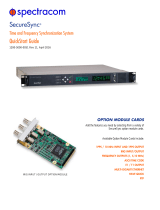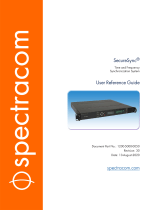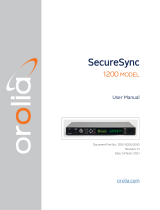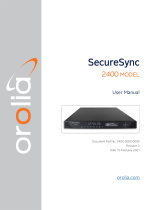Page is loading ...

SecureSync
®
Time and Frequency Synchronization System
Option Card Installation Guide
1200-5000-0052 Rev.6, November 2016

Contents
Introduction – SecureSync ......................................................................................................... 1
About this Document .................................................................................................................. 1
Outline of the Installation Procedure .......................................................................................... 1
PROCEDURE 1: Unpacking .................................................................................................. 3
Additional Equipment Needed For Installation ...................................................................................... 3
PROCEDURE 2: Saving Reference Priority Configuration (optional) ..................................... 3
PROCEDURE 3: Determining the Correct Installation Procedure .......................................... 4
PROCEDURE 4: Bottom Slot Installation ............................................................................... 5
PROCEDURE 5: Top Slot Installation, Bottom Slot Empty ..................................................... 6
PROCEDURE 6: Top Slot Installation, Bottom Slot Occupied ................................................ 8
PROCEDURE 7: Frequency Output Module Cards: Wiring ...................................................10
PROCEDURE 8: Gigabit Ethernet Module Card Installation, Slot 1 Empty ...........................11
PROCEDURE 9: Gigabit Ethernet Module Card Installation, Slot 1 Occupied ......................12
PROCEDURE 10: Alarm Relay Module Card, Cable Installation ............................................14
PROCEDURE 11: Verifying HW Detection and SW Update ...................................................15
Updating the System Software ............................................................................................................ 16
PROCEDURE 12: Restoring Reference Priority Configuration (optional) ................................17
Technical and Customer Support ..............................................................................................18

SecureSync
®
1 SecureSync
®
Option Card Installation Guide Rev.6
Introduction – SecureSync
The Spectracom SecureSync time and frequency synchronization system offers customizability and
expandability via the addition of a range of modular option cards.
Up to 6 cards can be accommodated to offer synchronization to a wide variety of references and devices.
An extensive number of traditional and contemporary timing protocols and signal types are supported
including:
• digital and analog timing and frequency signals (1PPS, 1MHz / 5MHz / 10 MHz)
• timecodes (IRIG, STANAG, ASCII)
• high accuracy and precision network timing (NTP, PTP)
• telecom timing (T1/E1), and more.
About this Document
This option card installation guide contains information and instructions for installing option module cards
in the Spectracom SecureSync unit.
NOTE:
The installation procedure varies, depending on the type of option card to be
installed.
Outline of the Installation Procedure
The general steps necessary for installing SecureSync option cards are as follows:
• If adding or removing option cards that provide a reference, optionally backup your SecureSync
configuration (refer to Section: “PROCEDURE 2: Saving Reference Priority Configuration”, if
applicable to your scenario or environment.)
• Safely power down the SecureSync unit and remove the chassis cover.
CAUTION:
NEVER install an option card from the back of the unit, ALWAYS from the top.
It is therefore necessary to remove the top cover of the main chassis (housing).
• Determine which slot the option card will be installed into.
• Prepare slot (if required), and plug card into the slot.
• Connect any required cables and secure option card into place.
• Replace chassis cover, power on unit.
• Log in to the SecureSync web interface; verify the installed card is identified.
• Restore SecureSync configuration (if it had been previously backed up in initial steps).Safety

SecureSync
®
SecureSync
®
Option Card Installation Guide Rev.6 2
Before beginning any type of option card installation, please carefully read the following safety statements
and precautions to ensure that the SecureSync unit has been safely and properly powered down (with all
AC and DC power cords disconnected). All installation instructions detailed henceforth in this document
assume that the SecureSync unit has been powered down in this manner.
Always ensure that you adhere to any and all applicable safety warnings, guidelines, or precautions
during the installation, operation, and maintenance of your product.
WARNING
The interior of this equipment does not have any user serviceable parts.
Contact Spectracom Technical Support if this equipment needs to be serviced.
This unit will contain more than one power source if both the AC and DC power options are
present. Turning off the rear panel power switch will not remove all power sources.
Ensure all power sources are removed from the unit prior to installing any option cards by
removing both the AC and DC power cords connected to the equipment.
Never remove the cover or blank option card plates with power applied to this equipment.
This equipment has Double Pole/Neutral Line Fusing on AC power.
CAUTION
Electronic equipment is sensitive to Electrostatic Discharge (ESD). Observe all ESD
precautions and safeguards when handling Spectracom equipment.

SecureSync
®
3 SecureSync
®
Option Card Installation Guide Rev.6
PROCEDURE 1: Unpacking
On receipt of materials, unpack and inspect the contents and accessories (retain all original packaging for
use in return shipments, if necessary).
The following additional items are included with the ancillary kit for the option card(s) and may be required
for installation depending upon your card type, and installation location:
Item
Quantity
Part Number
50-pin ribbon cable
1
CA20R-R200-0R21
Washer, flat, alum., #4, .125 thick
2
H032-0440-0002
Screw, M3-5, 18-8SS, 4 mm, thread lock
5
HM11R-03R5-0004
Standoff, M3 x 18 mm, hex, M-F, Zinc-pl. brass
2
HM50R-03R5-0018
Standoff, M3 x 12 mm, hex, M-F, Zinc-pl. brass
1
HM50R-03R5-0012
Cable tie
2
MP00000
Additional Equipment Needed For Installation
In addition to the parts supplied with your option card, the following items are required for installation:
• #1 Philips head screwdriver
• Cable tie clipper
• 6mm hex wrench.
PROCEDURE 2: Saving Reference Priority Configuration (optional)
When adding or removing option module cards which reference inputs such as IRIG Input, ASCII
Timecode Input, HAVE QUICK, 1-PPS Input, Frequency Input, etc., any user-defined Reference
Priority Input setup configuration will be reset back to the factory default state for the SecureSync
hardware configuration, and the user/operator will need to reconfigure the Reference Priority Table.
If you would like to continue using your current Reference Priority Input configuration without having to re-
enter it, Spectracom recommends to save the current SecureSync configuration before beginning with the
hardware installation. Please refer to the SecureSync Instruction Manual for additional information
(“Backing Up the System Configuration Files”).
After completion of the hardware installation, the SecureSync configuration can be restored (see
PROCEDURE 12).

SecureSync
®
SecureSync
®
Option Card Installation Guide Rev.6 4
PROCEDURE 3: Determining the Correct Installation Procedure
The option card installation procedure varies, depending on the the option card model, the chosen
installation slot, and if the bottom slot is used or not (for upper slots only).
(a) Identify the last two digits of the part number of your option card (see label on bag).
(b) Inspect the back of the SecureSync housing, and select an empty slot for the new card.
If the card is to be installed in one of the upper slots, take note if the
corresponding lower slot is occupied.
Figure 1: Rear view of SecureSync unit
(c) Consult Table 1: INSTALLATION STEPS below:
i. Find your part number in the left-hand column
ii. Choose your installation location (as determined above)
iii. When using an upper slot, choose the row bottom slot “empty” or “populated”
iv. Continue with the installation by following the PROCEDURES listed in the
corresponding row on the right hand side.
NOTE:
Follow only the PROCEDURES listed for your option card and installation scenario!
Table 1: INSTALLATION STEPS
Option card
Part No.
Card function
Installation
location
Bottom slot PROCEDURES
1204-08
1204-26
1204-1C/0C
Frequency output
Slot 2, 4, or 6
empty
(1), 2, 3, 5, 7, 11, (12)
populated
(1), 2, 3, 6, 7, 11, (12)
Slot 1, 3, or 5
(1), 2, 3,
4
,
7
, 11, (12)
1204-0F
Alarm relay
Slot 2, 4, or 6
empty
(1), 2, 3, 5, 7, 10, 11, (12)
populated
(1), 2, 3, 6, 7, 10, 11, (12)
Slot 1, 3, or 5
(1), 2, 3, 4, 7, 10, 11, (12)
1204-06
Gigabit Ethernet Slot 2
empty
(1), 2, 3, 8, 11, (12)
populated
(1), 2, 3, 9, 11, (12)
all other
Part Numbers
miscellaneous
Slot 2, 4, or 6
empty
(1), 2, 3, 5, 11, (12)
populated
(1), 2, 3, 6, 11, (12)
Slot 1, 3, or 5
(1), 2, 3, 4, 11, (12)
Slot 1
Slot 3
Slot 5
Slot 2
Slot 4
Slot 6

SecureSync
®
5 SecureSync
®
Option Card Installation Guide Rev.6
PROCEDURE 4: Bottom Slot Installation
This section provides instructions for installing an option card into a bottom slot (1, 3, or 5) of the
SecureSync unit.
(a) Safely power down the SecureSync unit and remove chassis cover.
CAUTION:
NEVER install an option card from the back of the unit, ALWAYS from the top.
It is therefore necessary to remove the top cover of the main chassis (housing).
(b) Remove blank panel or existing option card in the slot. If a card is populating the slot above
the bottom slot your option card is to be installed into, remove it.
(c) Insert the card into the bottom slot by carefully pressing its connector into the mainboard
connector (see Figure 2), and lining up the screw holes on the card with the chassis.
Figure 2: Connector installation
(d) Using the supplied M3 screws, screw the board and option plate into chassis, applying a
torque of 0.9 Nm/8.9 in-lbs.
CAUTION:
Ensure that screw holes on the card are properly lined up and secured to the
chassis before powering the unit up, otherwise damage to the equipment may
result.

SecureSync
®
SecureSync
®
Option Card Installation Guide Rev.6 6
PROCEDURE 5: Top Slot Installation, Bottom Slot Empty
This section provides instructions for installing an option card into an upper slot (2, 4, or 6) of the
SecureSync unit, with no card populating the bottom slot.
(a) Safely power down the SecureSync unit and remove chassis cover.
(b) Remove blank panel or existing option card.
(c) Place one of the supplied washers over each of the two chassis screw holes (see Figure 4),
then screw the 18 mm standoffs (= the longer standoffs) into the chassis (see Figure 3),
applying a torque of 0.9 Nm/8.9 in-lbs.
Figures 3 & 4: Washers & standoffs secured to chassis screw holes
(d) Insert option card into the slot, lining up the screw holes on the card with the standoffs.
(e) Using the supplied M3 screws, screw the board into the standoffs, and the option plate into
the chassis, applying a torque of 0.9 Nm/8.9 in-lbs.
(f) Take the supplied 50-pin ribbon cable and carefully press it into the connector on the
mainboard (lining up the red sided end of the cable with PIN 1 on the mainboard), then into
the connector on the option card (see Figure 5 next page).
Place washers above the
chassis screw holes, then
secure the 18 mm standoffs
above the washers.

SecureSync
®
7 SecureSync
®
Option Card Installation Guide Rev.6
Figure 5: Ribbon cable installation
CAUTION:
Ensure that the ribbon cable is aligned and fastened properly to all pins
on the connector of the card.
Otherwise, damage to equipment could result during power up.

SecureSync
®
SecureSync
®
Option Card Installation Guide Rev.6 8
PROCEDURE 6: Top Slot Installation, Bottom Slot Occupied
This section provides instructions for installing an option card into an upper slot (2, 4, or 6) of the
SecureSync unit, above a populated bottom slot.
(a) Safely power down the SecureSync unit and remove chassis cover.
CAUTION:
NEVER install an option card from the back of the unit, ALWAYS from the top.
It is therefore necessary to remove the top cover of the main chassis (housing).
(b) Remove blank panel or existing option card.
(c) Remove screws securing the card already populating the bottom slot.
(d) Screw the 18-mm standoffs into the option card populating the bottom slot (see Figure 6) ,
applying a torque of 0.9 Nm/8.9 in-lbs.
Figure 6: Bottom card with standoffs installed
(e) Insert option card into the slot above the existing card, lining up the screw holes with the
standoffs.
(f) Using the supplied M3 screws, screw the board into the standoffs, and the option plate into
the chassis, applying a torque of 0.9 Nm/8.9 in-lbs.
(g) Take the supplied 50-pin ribbon cable and carefully press it into the connector on the
mainboard (lining up the red sided end of the cable with PIN 1 on the mainboard), then into
the connector on the option card (see Figure 7 next page).
Remove screws from the
bottom card and replace
with 18 mm standoffs.

SecureSync
®
9 SecureSync
®
Option Card Installation Guide Rev.6
Figure 7: Ribbon cable installation
CAUTION:
Ensure that the ribbon cable is aligned and fastened properly to all pins on the
connector of the card. Otherwise, damage to equipment could result during power
up.

SecureSync
®
SecureSync
®
Option Card Installation Guide Rev.6 10
PROCEDURE 7: Frequency Output Module Cards: Wiring
This procedure includes additional installation instructions for the following option card types:
• Frequency Output module cards:
1 MHz (PN 1204-26)
5 MHz (PN 1204-08)
10 MHz (PN 1204-0C)
10 MHz (PN 1204-1C)
For the cable installation, follow the steps detailed below:
(a) Install the coax cable(s) onto the main PCB, connecting them to the first available open
connectors, from J1 - J4. Refer to figure below:
Figure 8: J Connectors
NOTE:
For 10 MHz option cards with 3 coax cables: From the rear of the option card, outputs
are labeled J1, J2, J3. Start by connecting the cable attached to J1 on the card to the
first available open connector on the SecureSync mainboard, then connect the cable
attached to J2, then J3 etc.
(b) Using the supplied cable ties, secure the coax cable from the option card to the white nylon
cable tie holders fastened to the mainboard.
J0 – Reserved for standard 10 MHz output.
J1
J2
J3
J4

SecureSync
®
11 SecureSync
®
Option Card Installation Guide Rev.6
PROCEDURE 8: Gigabit Ethernet Module Card Installation,
Slot 1 Empty
This procedure describes the installation of the Gigabit Ethernet module card (PN 1204-06), if slot 1 is empty.
NOTE:
The Gigabit Ethernet option card must be installed in Slot 2. If there is a card
already installed in Slot 2, it must be relocated to a different slot.
(a) Safely power down the SecureSync unit and remove chassis cover.
CAUTION:
NEVER install an option card from the back of the unit, ALWAYS from the top.
It is therefore necessary to remove the top cover of the main chassis (housing).
(b) Take the supplied washers and place them over the chassis screw holes.
Fig. 9: Washer placement
(c) Screw the supplied 18-mm standoffs into place above the washers (see Figure 10), applying
a torque of 0.9 Nm/8.9 in-lbs.
(d) On the SecureSync mainboard, remove the screw located under the J11 connector and
replace with the supplied 12-mm standoff (see Figure 10).
(e) Insert the Gigabit Ethernet option card into Slot 2, and carefully press down to fit the
connectors on the bottom of the Gigabit Ethernet card to the connectors on the mainboard.
(f) Secure the option card by screwing the supplied M3 screws into
- both standoffs on the chassis
- the standoff added onto the mainboard
- and into the rear chassis. Apply a torque of 0.9 Nm/8.9 in-lbs.

SecureSync
®
SecureSync
®
Option Card Installation Guide Rev.6 12
Figure 10: Gigabit Ethernet option card installation
PROCEDURE 9: Gigabit Ethernet Module Card Installation,
Slot 1 Occupied
This procedure describes the installation of the Gigabit Ethernet module card (PN 1204-06),
if there is an option card installed in slot 1.
NOTE:
The Gigabit Ethernet option card must be installed in Slot 2. If there is a card
already installed in Slot 2, it must be relocated to a different slot.
(a) Safely power down the SecureSync unit and remove chassis cover.
CAUTION:
NEVER install an option card from the back of the unit, ALWAYS from the top.
It is therefore necessary to remove the top cover of the main chassis (housing).
(b) Remove blank panel or existing option card.
(c) Remove the two screws securing the lower card (not the panel screws).
(d) Screw the supplied 18-mm standoffs into place, applying a torque of 0.9 Nm/8.9 in-lbs.
(e) On the SecureSync mainboard, remove the screw located under the J11 connector and
replace with the supplied 12-mm standoff (see Figure 11).
(f) Insert the Gigabit Ethernet option card into Slot 2, and carefully press down to fit the
connectors on the bottom of the card to the connector on the mainboard.
(g) Secure the option card by screwing the supplied M3 screws into
- both standoffs on the chassis
Remove existing screw
on mainboard and
replace with the supplied
12-mm standoff.
Place supplied washers
over the chassis screw
holes, then screw
18-
mm standoffs into
place.

SecureSync
®
13 SecureSync
®
Option Card Installation Guide Rev.6
- the standoff added onto the mainboard
- and into the rear chassis. Apply a torque of 0.9 Nm/8.9 in-lbs.
Figure11: Gigabit Ethernet
option card installation
18-mm standoffs
12-mm standoff

SecureSync
®
SecureSync
®
Option Card Installation Guide Rev.6 14
PROCEDURE 10: Alarm Relay Module Card, Cable Installation
This procedure describes additional steps for the installation of the Alarm Relay Output
module card (PN 1204-0F).
(a) Connect the supplied cable, part number 8195-0000-5000, to the
mainboard connector J19 “RELAYS”.
Figure 12: Cable routing
(b) Using the supplied cable ties, secure the cable, part number 8195-0000-5000, from the
option card to the white nylon cable tie holders fastened to the mainboard (see Figure 12).

SecureSync
®
15 SecureSync
®
Option Card Installation Guide Rev.6
PROCEDURE 11: Verifying HW Detection and SW Update
Prior to beginning managing any features or functionality provided by the new card, it is advisable to
verify the successful installation by ensuring the new option card has been detected by the
SecureSync unit.
(a) Re-install the top cover of the unit chassis (housing), using the saved screws.
(b) Power on the unit.
(c) Verify the successful installation by ensuring the card has been detected:
Securesync Web UI, ≤ Version 4.x
Open a web browser, and log in to the SecureSync web interface. Navigate to the
STATUS/INPUTS and/or STATUS/OUTPUTS pages. Information displayed on these pages will
vary depending upon your option module card/SecureSync configuration (for example, the Multi-
Gigabit Ethernet option module card has both input and output functionality, and so is displayed
in both pages).
NOTE:
If after an installation the card does not appear to be properly identified, it may be
necessary to update the SecureSync system software to the latest available version.
Figure 13: Example STATUS/INPUTS page – SecureSync web user interface
CAUTION:
Ensure that screw holes on the card are properly lined up and secured to the
chassis before powering the unit up, otherwise damage to the equipment may
result.

SecureSync
®
SecureSync
®
Option Card Installation Guide Rev.6 16
Figure 14: Example STATUS/OUTPUTS page – SecureSync web user interface
SecureSync Web UI, ≥ Version 5.0
Open a web browser, log in to the SecureSync Web UI, and navigate to INTERFACES > OPTION
CARDS: The new card will be displayed in the list.
• If the card does not appear to be properly identified, proceed with the System Software
update as described below, and then navigate to INTERFACES > OPTION CARDS again to
confirm the card has been detected.
• If the card has been detected properly, proceed with the Software update as described below
to ensure SecureSync and the newly installed card are using the same, latest available
version.
Updating the System Software
Even if the newly installed option card has been detected, and even if the latest System Software version
is installed on your SecureSync unit, you must (re-)install the software to ensure both SecureSync, and
the option card are using the latest software:
• Follow the System Software update procedure, as outlined in the main User Manual under
Software Updates
.
NEXT: Restore your reference priority configuration, as described in the following topic, and configure
other option card-specific settings, as described in the main User Manual.

SecureSync
®
17 SecureSync
®
Option Card Installation Guide Rev.6
PROCEDURE 12: Restoring Reference Priority Configuration (optional)
Prior to configuring the new card in the web user interface, the System Configuration Files need
to be restored, if you saved them under PROCEDURE 2.
Please refer to the SecureSync Instruction Manual under “Restoring the System Configuration
Files” for additional information.
The SecureSync Instruction Manual also describes the configuration and functionality of the
different types of option cards.

SecureSync
®
SecureSync
®
Option Card Installation Guide Rev.6 18
Technical and Customer Support
Should you require further assistance with the configuration or operation of your product, or have
questions or issues that cannot be resolved using the information in this document, please contact
Spectracom Technical/Customer Support at either our North American or European service centers, or
visit the Spectracom website at www.spectracom.com
:
NOTE: Premium Support Customers can refer to their service contracts for emergency 24 hour support.
North America
Phone
+1 585.321.5800
email
techsupport@spectracom.com
Europe
France
Phone
+33 (0)1 6453 3980
email
techsupport-france@spectracom.orolia.com
Document Revision History
Rev
ECO
Description
Date
A
2513
Version 1.
September 2010
B
2542
Updated with new option card information.
November 2010
C
2804
Updated to include information regarding addition / removal of
Input cards that provide a reference and
their effects on the
Reference Priority Table.
December 2011
D
2868
General updates and document maintenance.
February 2012
E
3373
Added HM50R-03R5-0012 standoff. Updated Gbit Ethernet
installation procedures, added Alarm Relay inst. procedure.
January 2014
6
DOC39
Added notes about chassis cover removal, and system software
update. General maintenance updates.
November 2016
/









